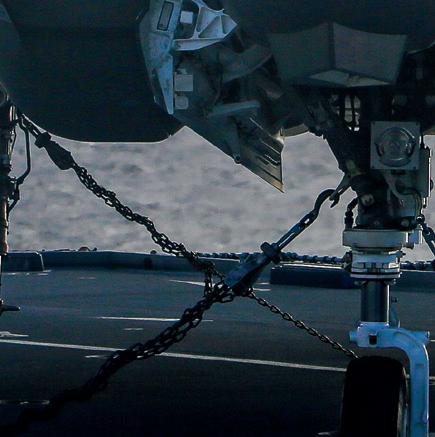
2 minute read
MCDONNELL FH-1 PHANTOM


Advertisement






The rst jet ghter to see operational service with the Marine Corps – and the US Navy – was McDonnell’s FH-1 Phantom.


FH-1 Phantom, Marine Phantoms aerobatic team, 1949. An aerobatic team known as the Marine Phantoms, equipped with ve FH-1 Phantoms, was formed within VMF-122. The team performed for some years and the aircraft sported this scheme, after initially ying in regular VMF-122 markings.
The McDonnell Aircraft Corporation was established in 1939 to manufacture aircraft components for the United States military, its founder James McDonnell having quit his former employer, the Glenn L. Martin Company, in 1938. It turned out to be exactly the right move as huge orders soon came rolling in, but McDonnell’s ambition had always been to design and build aircraft.
Therefore, during the autumn and winter of 1939, the Missouri-based company approached the USAAF with designs for a new ghter. This resulted in McDonnell being invited to participate in Request for Data R-40C on March 8, 1940 – which was for high-speed long-range bomber interceptor designs.





McDonnell’s twin pusher proppowered Model I lost out but the AAF thought highly enough of it to buy the data for $3000. The revised Model II was submitted on June 30, 1940. This also failed to attract an order but Model II-A was approved in May 1940 and McDonnell received a $1.6m contract to build its rst aircraft on September 30, 1941, under the designation XP-67. This was given the company name ‘Moonbat’.
This aerodynamically advanced but underpowered ghter was delivered on April 29, 1943. Early impressions were positive and it gave the US Navy suf cient con dence, on August 30, 1943, to award the company a contract to build it a twinengine jet ghter.



The resulting aircraft retained several of the Moonbat’s features – such as its tricycle undercarriage, a pronounced dihedral of its tail surfaces, forward-set full vision canopy and the swooping curves of its faired-in engine nacelles, though the jet ghter’s engines were positioned in the wingroots rather than being mid-wing.

The turbojets speci ed were Westinghouse WE-19XB-2Bs, each producing 1600lb of thrust. This was the rst all-American jet engine and would be later redesignated J30-WE-20. Armament was a quartet of .50-cal machine guns in the nose.
The Navy ordered two prototypes under the designation XFD-1 and the rst made its maiden ight on January 26, 1945, although short hops on a single engine had previously been carried out. With the type now undergoing ight testing, the Navy ordered a full production run of 100 aircraft on March 7, 1945. McDonnell continued the ‘spook’ theme begun with the Moonbat by calling the new aircraft ‘Phantom’.
Changes for the production model would include an 18in fuselage extension, a shorter rudder and shorter tailplanes. There was also the option to install an aerodynamic external fuel tank below the fuselage and the aircraft’s windscreen was redesigned to improve visibility.





The production order was slashed to 60 when the Second World War ended and the rst prototype was destroyed in a crash on November 1, 1945. The second prototype became the rst pure jet ghter to make an arrested landing on a US carrier – USS Franklin D. Roosevelt – on July 21, 1946, and the rst production FD-1 made its ight debut on November 28.
Navy ghter squadron VF-17A received its rst Phantom on July 23, 1947, shortly after the type had been redesignated FH-1, and the rst (and only) US Marine Corps squadron to receive it was VMF-122 in November 1947. This made VMF-122 the rst USMC combat squadron ever to deploy jets. And while the US Navy’s Blue Angels were still ying F8F Bearcats, the Marines established their own display team called the Marine Phantoms, aka the Flying Leathernecks.
VMF-122 would also be the last active squadron left ying the FH-1, nally phasing it out on July 1, 1950. Phantoms would continue in service with training and reserve units until 1954.
The Phantom was not well suited to the USMC’s requirements – lacking any ground-attack capability beyond stra ng targets with its machine guns. It also had weak engines and when its guns were red in low-light conditions they tended to dazzle the pilot. But before long much more capable aircraft would be made available.




